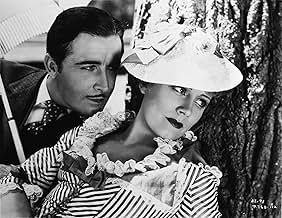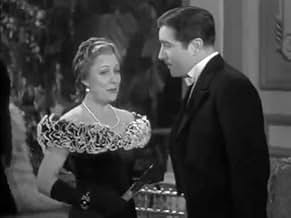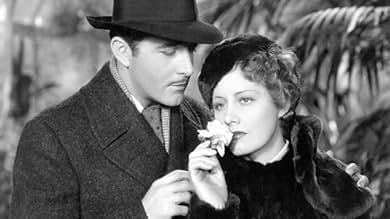Ajouter une intrigue dans votre langueAn engaged attorney and a divorcee fall for each other in 1870s Manhattan.An engaged attorney and a divorcee fall for each other in 1870s Manhattan.An engaged attorney and a divorcee fall for each other in 1870s Manhattan.
- Réalisation
- Scénario
- Casting principal
- Récompenses
- 3 victoires au total
Barry O'Moore
- Mr. Welland
- (as Herbert Yost)
Lowden Adams
- Jenkins
- (non crédité)
Muriel Barr
- Miss Allison - Jenkins' Daughter
- (non crédité)
Harry Beresford
- Museum Guard
- (non crédité)
Lynn Browning
- Miss Archer
- (non crédité)
Herbert Bunston
- W.J. Letterblair
- (non crédité)
Bess Flowers
- Child's Mother
- (non crédité)
Alf James
- Man Who Comes with Chairs
- (non crédité)
John Merton
- John
- (non crédité)
Avis à la une
THE AGE OF INNOCENCE (RKO 1934) (81 minutes)
There have been three film versions of Edith Wharton's most renowned novel, The Age of Innocence. The 1924 silent version is lost. We are left with Martin Scorcese's definitive 1993 version in wide screen and color, derived from the novel itself with its multitude of characters and subplots, and this charming early talkie, based on a play version of the book.
Although the plot and narrative have been pared down considerably, the meat of the matter is still here and it is given first class treatment. Irene Dunne is radiant (when was she not?) in the role of the expatriate family member, Ellen, married into European royalty, and returned to 1870s New York Society, and John Boles gives a solid reading of the tortured Newland, a young lawyer betrothed to marry May Mingott, an innocent ingenue, while falling in love with her cousin, the experienced Ellen. It is true melodrama, a touching and tragic love story, played out in lush Hollywood style.
The sets are excellent as is the detailed and creative costume design. Helen Westley, in but 9 scenes, steals the show as the wise and down to earth Granny Mingott, while Julie Haydon over emotes as the clueless May. Max Steiner's score relies heavily on Tchaikovsky, whose song, None But The Lonely Heart, serves as the main motif running throughout the film. Mason and Heerman, who had just won a Screenplay Oscar for Little Women, deliver a marvelous adaptation, as they would for many more novels, including Magnificent Obsession, Imitation of Life, Golden Boy, and Stella Dallas. There is a long and frantic montage at the film's beginning, establishing the mood of Jazz Age madness and scandalous headlines, against which the calm staidness of New York 19th century society will be played out.
Westley and Dunne would appear opposite each other two years later in SHOW BOAT, while Laura Hope Crewes (as Mrs. Welland) and costume designer, Walter Plunkett, would be paired for 1939's Gone With The Wind.
The available dvd print is impeccably crisp and clean. Although the categories had not yet been created in 1934, a supporting actress nod would be due Helen Westley and a costume design nomination is due Walter Plunkett, in my humble opinion.
If you love Wharton, you will enjoy both the Scorcese version and this lovely gem from Hollywood's golden decade.
There have been three film versions of Edith Wharton's most renowned novel, The Age of Innocence. The 1924 silent version is lost. We are left with Martin Scorcese's definitive 1993 version in wide screen and color, derived from the novel itself with its multitude of characters and subplots, and this charming early talkie, based on a play version of the book.
Although the plot and narrative have been pared down considerably, the meat of the matter is still here and it is given first class treatment. Irene Dunne is radiant (when was she not?) in the role of the expatriate family member, Ellen, married into European royalty, and returned to 1870s New York Society, and John Boles gives a solid reading of the tortured Newland, a young lawyer betrothed to marry May Mingott, an innocent ingenue, while falling in love with her cousin, the experienced Ellen. It is true melodrama, a touching and tragic love story, played out in lush Hollywood style.
The sets are excellent as is the detailed and creative costume design. Helen Westley, in but 9 scenes, steals the show as the wise and down to earth Granny Mingott, while Julie Haydon over emotes as the clueless May. Max Steiner's score relies heavily on Tchaikovsky, whose song, None But The Lonely Heart, serves as the main motif running throughout the film. Mason and Heerman, who had just won a Screenplay Oscar for Little Women, deliver a marvelous adaptation, as they would for many more novels, including Magnificent Obsession, Imitation of Life, Golden Boy, and Stella Dallas. There is a long and frantic montage at the film's beginning, establishing the mood of Jazz Age madness and scandalous headlines, against which the calm staidness of New York 19th century society will be played out.
Westley and Dunne would appear opposite each other two years later in SHOW BOAT, while Laura Hope Crewes (as Mrs. Welland) and costume designer, Walter Plunkett, would be paired for 1939's Gone With The Wind.
The available dvd print is impeccably crisp and clean. Although the categories had not yet been created in 1934, a supporting actress nod would be due Helen Westley and a costume design nomination is due Walter Plunkett, in my humble opinion.
If you love Wharton, you will enjoy both the Scorcese version and this lovely gem from Hollywood's golden decade.
This "Age of Innocence" from 1934, of course, cannot even approach the sumptuous beauty.amazing acting, and rich story-telling of the Martin Scorsese "Age of Innocence" from 1993 starring Daniel Day-Lewis, Winona Ryder, and Michelle Pfeiffer.
The 1934 movie stars Irene Dunne as Ellen, John Boles as Newland, and Julie Haydon as May.
The story is told in flashback by the elderly Newland. As a young attorney in the late 1800s, he was engaged to May when her cousin Ellen came to visit from Europe. She plans to divorce her husband and is a social outcast, as these things were never done. Newland and Ellen fall in love. Do they defy convention and marry? Or does Newland marry May as promised?
Irene Dunne is lovely as Ellen. She was an actress who could do comedy and drama. John Boles was a huge star and not a tremendous actor. That kind of look was considered attractive way back when; today it has gone out of style.
There are good performances, but there is no way to watch this film after seeing the Scorsese film. It is studio-made, looks dull, and is dull. This is a story with a great deal of depth that seems untouched here -- lots going on underneath all the gentility, the trap of conventions -- here told as an ordinary story.
Helen Westley is wonderful as the cousins' grandmother, as is Laura Hope Crews as Dunne's aunt and May's mother. Lionel Atwill is also on hand as a married man who is a friend of Dunne's, an unacceptable situation.
The novel was also adapted into a play, on Broadway starring Katherine Cornell as Ellen and Franchot Tone as Newland.
If you haven't seen the stunning Scorsese film, see it.
The 1934 movie stars Irene Dunne as Ellen, John Boles as Newland, and Julie Haydon as May.
The story is told in flashback by the elderly Newland. As a young attorney in the late 1800s, he was engaged to May when her cousin Ellen came to visit from Europe. She plans to divorce her husband and is a social outcast, as these things were never done. Newland and Ellen fall in love. Do they defy convention and marry? Or does Newland marry May as promised?
Irene Dunne is lovely as Ellen. She was an actress who could do comedy and drama. John Boles was a huge star and not a tremendous actor. That kind of look was considered attractive way back when; today it has gone out of style.
There are good performances, but there is no way to watch this film after seeing the Scorsese film. It is studio-made, looks dull, and is dull. This is a story with a great deal of depth that seems untouched here -- lots going on underneath all the gentility, the trap of conventions -- here told as an ordinary story.
Helen Westley is wonderful as the cousins' grandmother, as is Laura Hope Crews as Dunne's aunt and May's mother. Lionel Atwill is also on hand as a married man who is a friend of Dunne's, an unacceptable situation.
The novel was also adapted into a play, on Broadway starring Katherine Cornell as Ellen and Franchot Tone as Newland.
If you haven't seen the stunning Scorsese film, see it.
I have seen Scorsese's film many times and have always loved the luxurious attention to detail, but always thought Mae was miscast and there wasn't much humor, it was more of a melodramatic romance than a statement on values and morals of the time, so I was hesitant to watch this version, figuring it would be boring and predictable...
Instead, I was pleasantly surprised, this film actually had the depth, humor and awareness that I did not find in Scorsese's film. The movie is also remarkably adult for its time, and totally believable as well as faithful to the novel; the dialog was crisp, quick and mature and the story moved along steadily.
Nobody seems miscast or out of place and unlike other reviewers, I didn't find any problem with John Bole's performance, I thought he conveyed exactly what he was supposed to and was even less wimpy than Daniel Day-Lewis's performance in the Scorsese film.
Overall I recommend this version highly, and while I do prefer the pace of this film, it will never compare to the visual sumptuousness of the Scorsese version.
Instead, I was pleasantly surprised, this film actually had the depth, humor and awareness that I did not find in Scorsese's film. The movie is also remarkably adult for its time, and totally believable as well as faithful to the novel; the dialog was crisp, quick and mature and the story moved along steadily.
Nobody seems miscast or out of place and unlike other reviewers, I didn't find any problem with John Bole's performance, I thought he conveyed exactly what he was supposed to and was even less wimpy than Daniel Day-Lewis's performance in the Scorsese film.
Overall I recommend this version highly, and while I do prefer the pace of this film, it will never compare to the visual sumptuousness of the Scorsese version.
Young Kane Richmond is coming to his grandfather John Boles for advice about
women. He's looking to marry a divorcee and the family is just buzzing. Except
for Grandpa and Richmond suspects something.
His suspicions prove correct as John Boles proceeds to tell him about his romantic youth in the Gilded Age when he passed up Irene Dunne who is in fact his sister-in-law. Neither of the two were ready to defy very strict conventions of the time that still held firm in some respects when this film was released. Divorce was a big no-no
Both the leads did well though I really couldn't see Lionel Atwill as anyone's romantic rival. Helen Westley as the grandmother came off best in the supporting cast.
Taken from an Edith Wharton novel the play by Margaret Ayer Barnes ran 207 performances on Broadway and starred the legendary Katherine Cornell. Now that I would have liked to see.
His suspicions prove correct as John Boles proceeds to tell him about his romantic youth in the Gilded Age when he passed up Irene Dunne who is in fact his sister-in-law. Neither of the two were ready to defy very strict conventions of the time that still held firm in some respects when this film was released. Divorce was a big no-no
Both the leads did well though I really couldn't see Lionel Atwill as anyone's romantic rival. Helen Westley as the grandmother came off best in the supporting cast.
Taken from an Edith Wharton novel the play by Margaret Ayer Barnes ran 207 performances on Broadway and starred the legendary Katherine Cornell. Now that I would have liked to see.
Edith Wharton chronicled the romantic tragedies of the 19th century 400, those anointed people who would fit in Lady Astor's Lavish New York Society ballroom. This 1934 film is the story of a young lawyer named Newland Archer who is pledged to a New York girl named May Welland. The marriage is in the offing for most of the film.
What stirs things up is the arrival of a mysterious woman, a Polish Countess named Ellen Olenska, who lives at an unfashionable Manhattan address, west 23rd street. Newland is charmed by the Countess and she, likewise. The Countess is in town to get a divorce. Society is as put off by Mrs. Olenska's frankness as they are with her address.
Teacups rattle at every social turn. Irene Dunne is younger in this film as Countess Olenska than in any other I've seen her in. She upstages every other actor in the film including John Boles who is inept as Newland. The movie seems a star vehicle for Dunne. At least the 1993 remake of Age of Innocence from Director Martin Scorcese gives some weight to the other characters, while failing finally to tell the story adequately. Julie Haydon, who would eventually play Laura in Tennessee Williams' play The Glass Menagerie, is suitably church-mousey as Newland's fiancee, May.
Newland's interest in and defense of the Countess eventually gets him in trouble with the upper-class set who are his peers. When push comes to shove, the question is, what will Archer do, dump the one he promised or run off with the Countess. What actually does happen is a fairly delicate bit of story-telling.
The 1934 Age of Innocence tells the story better than the 1993 version. But the older story isn't really that good either. Mrs. Wharton's novel was a sophisticated piece of work. It deserved a better telling on-screen. If you'd like a well-done thirties social drama, have a look at Dodsworth with Walter Huston, Ruth Chatterton and Mary (yes!) Astor. Age of Innocence is strictly for Irene Dunne aficianados.
What stirs things up is the arrival of a mysterious woman, a Polish Countess named Ellen Olenska, who lives at an unfashionable Manhattan address, west 23rd street. Newland is charmed by the Countess and she, likewise. The Countess is in town to get a divorce. Society is as put off by Mrs. Olenska's frankness as they are with her address.
Teacups rattle at every social turn. Irene Dunne is younger in this film as Countess Olenska than in any other I've seen her in. She upstages every other actor in the film including John Boles who is inept as Newland. The movie seems a star vehicle for Dunne. At least the 1993 remake of Age of Innocence from Director Martin Scorcese gives some weight to the other characters, while failing finally to tell the story adequately. Julie Haydon, who would eventually play Laura in Tennessee Williams' play The Glass Menagerie, is suitably church-mousey as Newland's fiancee, May.
Newland's interest in and defense of the Countess eventually gets him in trouble with the upper-class set who are his peers. When push comes to shove, the question is, what will Archer do, dump the one he promised or run off with the Countess. What actually does happen is a fairly delicate bit of story-telling.
The 1934 Age of Innocence tells the story better than the 1993 version. But the older story isn't really that good either. Mrs. Wharton's novel was a sophisticated piece of work. It deserved a better telling on-screen. If you'd like a well-done thirties social drama, have a look at Dodsworth with Walter Huston, Ruth Chatterton and Mary (yes!) Astor. Age of Innocence is strictly for Irene Dunne aficianados.
Le saviez-vous
- AnecdotesThe original Broadway production starred Katharine Cornell as Ellen Olenska, and Franchot Tone as Newland Archer.
- GaffesAs evidenced by a dated letter, Newland assisted Ellen with her divorce case in August 1879. Newland and May were married just after the following Easter, which would make it 1879. After returning from their honeymoon, they receive an invitation for a party on Wednesday, October 2nd. That would be correct if it was still 1878, but in 1879, October 2nd was a Thursday.
- Citations
Julius Beaufort: After all your exquisite associations over there, how do you think you're going to like it here?
Ellen: I think it quite like heaven.
Julius Beaufort: Yes, I have that feeling too sometimes. You mean, just some place to go after you're dead?
- ConnexionsReferences À l'Ouest rien de nouveau (1930)
- Bandes originalesNone But the Lonely Heart
(1869) (uncredited)
Music by Pyotr Ilyich Tchaikovsky
Played during the opening credits and often as background music
Meilleurs choix
Connectez-vous pour évaluer et suivre la liste de favoris afin de recevoir des recommandations personnalisées
- How long is The Age of Innocence?Alimenté par Alexa
Détails
- Date de sortie
- Pays d’origine
- Langues
- Aussi connu sous le nom de
- La edad de la inocencia
- Lieux de tournage
- Société de production
- Voir plus de crédits d'entreprise sur IMDbPro
- Durée1 heure 21 minutes
- Couleur
- Rapport de forme
- 1.37 : 1
Contribuer à cette page
Suggérer une modification ou ajouter du contenu manquant

Lacune principale
By what name was The Age of Innocence (1934) officially released in India in English?
Répondre
































